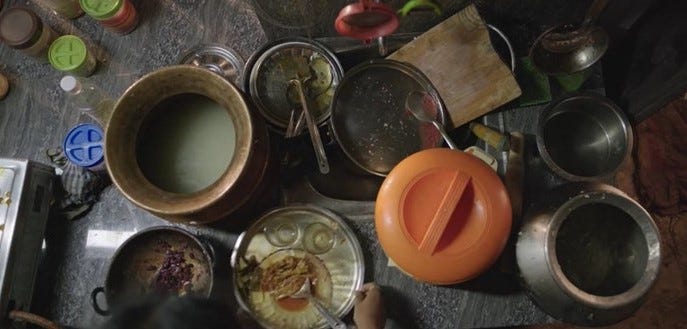Let me set mise-en-scéne for you—a bag of fresh produce, coriander, spring onions, tomatoes etc, picked up carefully from a local market, spread on the kitchen slab—almost in a random abstract fashion - unintentional but beautiful, then the washing, prepping, cooking, clinking, pressure cooker’s whistle, eventually putting food on the table, then again the cleaning, washing and prepping for the next meal. This could be what you saw in The Great Indian Kitchen1 in 2021 or its 2025 remake Mrs.2 or these are the set of scenes you see or don’t see it in your own house everyday.
Setting the scene
The concept of mise-en-scéne, as one of my video-editor friends explained is setting the vibe, the aesthetic, the parts of the scene that fill the extra, often out of focus space in the frame, the way light falls, what the viewer sees as objects on screen etc. The setting is an important characteristic for reinforcing the mood of the scene. Whereas, cinematography is how a scene is shot — wide shot, zoomed in, a fast-cut, so on and so forth. Because the space in the frame is limited, everything needs to fit into a four-cornered box, no matter how much one tries, they cannot see beyond the edges of their devices.
The mise-en-scéne is dominated by kitchen articles signifying the monotonous, continuous and thankless work performed by the women from dawn to dusk. The camera takes time to show every detail of what happens before and after each meal, which has rarely been attempted on screen before. The grimy walls, the littered floor, the messy gas stove and cooking slab, the clogged sink, the leaking drainpipe, and the overused table to chop vegetables dictate each frame. The frames also foreground the girl, the mother-in-law and the occasional helper Usha who are constantly engaged in housekeeping activities; the worn out and disinterested expressions on their faces is homogeneous and fixed. The mise-en-scéne also consciously pivots on the interiors of the house and eschews point-of-view shots of the outside world from the perspective of women.
-Dr. Sajna Sanal, Negotiating Domestic Space and Agency through Mise-en-scéne in The Great Indian Kitchen (2021)3
Dr. Sanal describes the scene in such a vivid detail that one can almost imagine the movie playing. The camera also takes us to show the grim details of the aftermath — which gives you the ick. It’s nauseating to even watch, you can feel the disgust that the protagonist feels fairly quickly in the movie. In Mrs., the husband tells the wife that she smells of the kitchen, and as a viewer you can almost smell it. The setting is an imperative component to let the viewers in, the mise-en-scéne is set to show the parts our daily lives that often remains invisible. And what does looking at the same things on screen does? It is almost as if one puts blinders on while watching something on screen, the sense are heightened, you are oblivious to anything that falls on the corners of the screen, and you see the same things you would have seen in real life more closely. This is even true for the reels on social media — we see the main thing in focus, but we also watch the details around the subject more closely. If there were no words, dialogues to push the narrative, can the mise-en-scéne with it’s silence enough to dictate the essence of the narrative? What do you really see when you see a kitchen sink full of dirty, unwashed utensils?
Repetition
Have you watched The Bear?4 Do you remember the episode Forks ( Season 2, Episode 7) in which Richie works as at fancy restaurant and his task for a over a week only included cleaning/polishing the forks. The episode if you recall ( no spoiler alert, but if you haven’t watched it, please do) shows Richie’s daily life, his daily grind of waking up at the same time, getting to work, and cleaning forks. The repetition in the episode shows the daily effort of doing the work and what it leads to..In Richie’s case the routine was part of the hustle to success ( becoming front-of-the-house). This is similar to Dev’s routine in the movie Tamasha,5 which reeks of monotony and lack of success, it portrays the unsuccessful attempt of doing something every day and it leading to mostly nothing. As a viewer, repetition reinforces the narrative to the corners of ones brain — it is as if I am building a habit for 21 days and can finally call myself someone who goes to the gym everyday.
The repetition of prepping, cooking, washing, cleaning in the case of The Great Indian Kitchen and Mrs. becomes a leitmotif — a recurring theme that compels you to hyper-fixate on the scene. And while you get absorbed in the mundanity of the scene, it forces you the see beyond it.
The repetition does not demotivate the spectators, instead emphasizes the urgent need to reassess the politics the politics of gender lurking hideously in the kitchen
-Dr. Sajna Sanal, Negotiating Domestic Space and Agency through Mise-en-scéne in The Great Indian Kitchen (2021)
I think the point of repetition is to eventually build a habit. When one repeats something over and over again for a period of time, it is almost as if it is an embodied practice. Then, repetition becomes tradition, then culture and eventually nostalgia. It normalises the action where the actor assumes a certain kind of responsibility/ownership over a task. I am thinking about Japanese Mother and Obentōs: The Lunch Box as Ideological State Apparatus,6 where Allison talks about how ideology becomes so powerful that we start identifying it as who were are.
This commonsense acceptance of a particular world is the work of ideology, and it works by concealing the coercive and repressive elements of our everyday routines but also by making routines of everyday familiar, desirable and simply our own.
-Anne Allison, Japanese Mothers and Obentōs: The Lunch-Box as Ideological State Apparatus
In the movies The Great Indian Kitchen and Mrs., the wives wake up on the first day after the wedding and enter straight into the kitchen..why? Where else would they do? What else would they do?
Disrupting the narrative
In Season One of South Korea’s TVN’s television drama, Let’s Eat (식샤를 합시다), the character Lee Soo-kyung, who is played by an actress of the same name, is a divorcee living alone with her dog in a nondescript apartment. Habitually snacking, especially when she is confronted by work-related stress, Soo-kyung’s appetite and her indulging in food alone often result in her being on the receiving end of public derision and embarrassment…..Although Soo-kyung acknowledges her date at first by nodding and smiling at him modestly, her poise quickly fades away and she is seen tearing the strands of meat from the spicy crabs with her gravy-stained fingers. As she opens her mouth widely to consume an entire squid’s tentacle, Soo-kyung slips into a gastronomic oblivion. It is these moments of oblivion to the otherwise highly gendered table etiquette of polite feminine restraint that defines this drama which spans two seasons from 2013 to 2015.
-Eunice Lim Ying Ci and Liew Kai Khiun, Her Hunger Knows No Bounds, ROUTLEDGE HANDBOOK OF FOOD IN ASIA
As a woman, you know there are some people who you can eat comfortably or eat a lot with..but there’s a narrative you stick to when you eat in public with other, mostly random people. What you see on the screen sometimes disrupts the stories you have been told, the stuff you have seen daily to the point of blur. Even hearing a woman burp after a satisfying meal, makes ones ears pop. So if a woman (on social media) is dressed from head to toe, hair perfectly set, red lip, cooking for her family, what is your first thought?7
I asked one of my friends who creates recipes on social media if her hair is always open while she is cooking. And just how are people even doing that? A lot of food content creators in India, show up fully dressed in their sarees, some even with their jewellery on. Is it performance? Is it reality? And does it matter?
Negotiating Domestic Space and Agency through Mise-enscéne in The Great Indian Kitchen (2021), Dr. Sajna Sanal , Associate Professor, Dept. of English, University College, Thiruvananthapuram
Watch The Bear already!
Watchable.
Anne Allision, Japanese Mother and Obentōs: The Lunch Box as Ideological State Apparatus, is must read. I also talked about the same reading in our last newsletter.
Alicia Kennedy has written On Tradwives recently. Go read it.
Food is a portal to understanding our world, our communities and ourselves. It provides a unique and critical perspective on everything—from everyday habits to global issues, from the way we design our countries, cities to how we navigate climate crises.
dhoop uses food as a lens. Through this lens, we can interrogate culture, sustainability, design and the systems that sustain life. Initially, we started as a magazine focused on stories of food and its intersections. Over time, it has grown into something more profound—a space, a research platform, embracing a multidisciplinary approach that invites collaboration and deeper inquiry.







